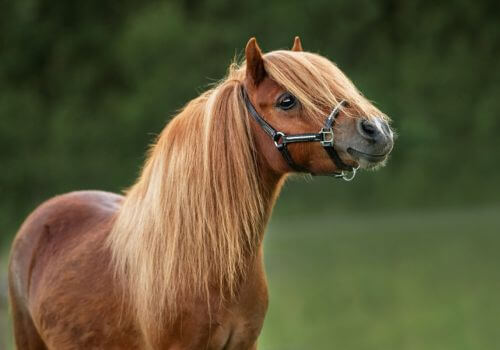The Shetland Pony: Tiny but Tough!
- Weight: 400 to 450 pounds
- Height: 7 hands (28 inches) to 11 hands (44 inches); up to 11.5 hands (46 inches) for American Shetlands
- Body Type: Compact body; broad head; thick neck; short legs; lush mane and tail
- Best For: All levels of owners and riders, including children
- Life Expectancy: 30 years or more

A Tough Little Pony with a Rich History
The Shetland Pony has inhabited the Shetland Islands off the coast of Scotland for thousands of years. The breed likely originates from Celtic ponies, later influenced by Norse ponies brought by Viking settlers. These hardy ponies developed resilience and strength to thrive in the harsh island environment. Historically, Shetland Ponies were used for farm work, pulling carts, and even laboring in coal mines during the Industrial Revolution. Today, they remain popular as children’s mounts, driving ponies, and companion animals. The Shetland Pony Stud-Book Society was established in 1890 to register and maintain the breed.
How Small is a Shetland Pony?
Shetland Ponies are such fascinating little creatures, and when we say little, we really mean it! Although they only stand between 7 and 11 hands high, with some American Shetlands reaching up to 11.5 hands, their strength is remarkable. These little ponies can pull loads that are even heavier than their own weight, showcasing just how powerful they really are!
What Makes a Shetland Pony Special?
Originally bred to help out on farms and with mining, Shetland Ponies have become favorites for leisurely drives, perfect for kids learning to ride, and excellent therapy animals. You can often spot them at horse shows, where their pleasant personalities and strong, sturdy builds make them adored by all.
Colors and Markings of Shetland Ponies
Shetland Ponies come in a variety of colors, including black, chestnut, bay, gray, dun, palomino, and roan. Pinto variations are common, but leopard-spotted coats (like Appaloosas) are not permitted in breed registries.
The Shocking Strength of a Shetland Pony
Shetland Ponies are known for their exceptional strength, often said to be capable of pulling more weight per pound than a Clydesdale. Their thick, double-layered coats help them survive extreme weather conditions. They also have a long lifespan, often exceeding 30 years.

Feeding Your Shetland Pony: Less is More
Shetland Ponies have incredibly efficient metabolisms, which means they don’t need a lot of food! They do best with high-quality grass hay and generally only need grain if they’re particularly active. Just keep in mind that overfeeding can lead to obesity and some health concerns, so it's important to measure their portions carefully.
Common Health Issues for Shetland Ponies
Shetland Ponies, although typically healthy, are susceptible to laminitis, particularly when grazing on lush pastures. Their compact stature may also lead to heart issues. For owners to reduce these risks, a balanced diet and regular exercise are important.
Grooming a Shetland Pony: Keeping Their Thick Coat in Check
In winter, Shetland Ponies grow thick, dense coats that require regular brushing to prevent matting. Their manes and tails should be combed frequently, and their hooves cleaned daily to prevent infections. Regular veterinary checkups are always recommended to ensure their health and longevity.
Bringing It Back to the Barn
Shetland Ponies are hardy, intelligent, and affectionate animals that make excellent companions. Whether used for riding, driving, or simply as a beloved pet, their friendly and adaptable nature ensures they remain a favorite among horse enthusiasts.
